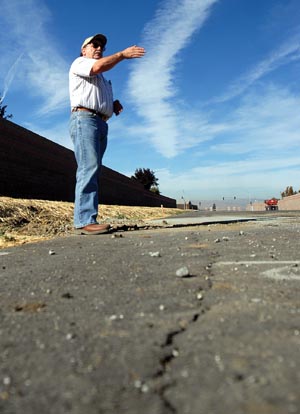
Kerry Theran, the resident engineer for Quincy Engineering that
manages oversight for the project, said the problem will push
completion to at least
”
closer to the end of December.
”
But he cautioned that if it starts raining now and doesn’t stop
until March,
”
obviously, we won’t be doing anything out here.
”
HOLLISTER
Timing for the opening to the new Highway 25 bypass is now in the hands of Mother Nature.
The Council of San Benito County Governments and its contractor, Graniterock/Pavex, discovered cracks along significant portions of the bypass’ shoulder. Kerry Theran, the resident engineer for Quincy Engineering that manages oversight for the project, said the problem will push completion to at least “closer to the end of December.” But he cautioned that if it starts raining now and doesn’t stop until March, “obviously, we won’t be doing anything out here.”
COG Executive Director Lisa Rheinheimer although the grand opening is delayed, the agency is working with the contractor to “complete critical areas to minimize impact to the public.”
Theran estimated that 20 percent to 30 percent of the shoulders have cracks, but that there’s “evidence that other areas are affected.”
“This is typical of what we have found,” said Theran, as he pointed to a crack about a yard long and a quarter-inch thick.
The cracks, according to the engineer, are a result of improper amounts of lime being applied to the shoulders before pavement was laid.
“Lime changes clay in the soil into something that does not expand or contract as much,” Theran explained to the Free Lance. “If you don’t have enough lime the soil, it’s just like a farmer’s land where you see big cracks in a field. That’s what is happening here.”
Large sections of the shoulders now must be dug up and repaired before striping can be done to finish the project. That striping, however, can occur only in decent weather conditions, and repairs are estimated to take several weeks to complete.
Once all the cracks were identified, Pavex began performing core tests on sections with no cracks to determine other areas where there is not enough lime.
“We are making him repair any area that is 20 inches deep and has no lime,” said Theran, adding that the core tests revealed lime levels to be anywhere from six to 36 inches deep.
The contractor has a powerful motive to finish the repairs as soon as possible – big fines.
“It’s called ‘liquid damages,'” said Theran, noting that Pavex will be fined $8,600 a day after the agreed upon date. That would equal $266,000 for the month of December.
Theran also stressed there was “no indication” the contractor had skimped purposely on lime, explaining how the problem arose due to the lime-laying equipment working against a dirt wall.
“The tines weren’t mixing the soil properly because the equipment abutted the wall,” said Theran. “He knew that was causing gaps so he physically mixed the soil and put it back in place, but he didn’t catch all the gaps.”
A press release from COG summarized the situation as follows.
“The biggest unknown in terms of the completion date is the fall and winter weather. A temperature of 50 degrees is needed to pave and stripe. In order to pave and stripe the shoulders, the contractor must dig up and replace the shoulder foundation. This will take several weeks to complete. However, concurrent paving and striping will occur where possible.”
A Graniterock/Pavex representative could not be reached immediately for comment.








